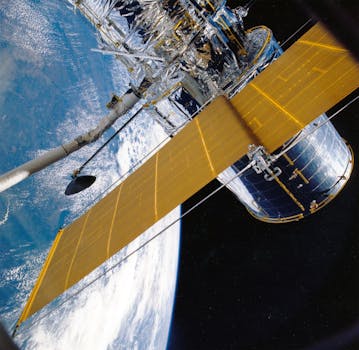
Updates from Above: Essential Insights into the Latest in Satellite Telecommunications
Satellite Telecommunications: The Focus Keyword for a Connected World
Satellite telecommunications has become a vital component of modern communication systems, providing connectivity to remote and underserved areas around the globe. The latest advancements in satellite technology have enabled faster, more reliable, and more secure communication services, transforming the way we live and work. In this article, we will delve into the latest updates in satellite telecommunications, exploring the current trends, innovations, and applications that are shaping the industry.
One of the significant developments in satellite telecommunications is the launch of new satellite constellations, such as Low Earth Orbit (LEO) and Medium Earth Orbit (MEO) satellites. These constellations offer improved coverage, capacity, and latency, enabling a wide range of applications, including broadband internet, mobile connectivity, and IoT services. Companies like SpaceX, OneWeb, and Amazon’s Kuiper Systems are at the forefront of this revolution, launching thousands of satellites into orbit to provide global connectivity.
Advances in Satellite Technology
Recent advances in satellite technology have led to the development of more efficient, compact, and powerful satellites. The use of advanced materials, such as carbon fiber and 3D printing, has enabled the creation of smaller, lighter satellites that are easier to launch and deploy. Additionally, the integration of artificial intelligence (AI) and machine learning (ML) algorithms has improved satellite performance, enabling real-time data processing, autonomous operation, and predictive maintenance.
The adoption of new satellite transmission technologies, such as beam-hopping and frequency reuse, has also increased the efficiency and capacity of satellite communications. These technologies allow for more flexible and dynamic use of satellite bandwidth, enabling the provision of high-speed internet and mobile services to a larger number of users. Furthermore, the development of advanced antennas and propulsion systems has improved the maneuverability and lifespan of satellites, reducing the need for replacement and minimizing the risk of collisions.
Applications and Trends
The latest updates in satellite telecommunications have opened up new opportunities for a wide range of applications, including broadband internet, mobile connectivity, IoT, and navigation. The increasing demand for satellite-based services has driven the growth of the satellite telecommunications market, with the global market expected to reach $14.8 billion by 2027. The adoption of satellite technology has also enabled the development of new business models, such as satellite-as-a-service and managed satellite services, which provide customers with flexible and scalable solutions for their communication needs.
In addition to these trends, the satellite telecommunications industry is also witnessing a shift towards more sustainable and environmentally friendly practices. The use of solar-powered satellites, green propulsion systems, and responsible satellite disposal methods is becoming more prevalent, reducing the environmental impact of satellite operations. Moreover, the development of satellite-based Earth observation systems has enabled the monitoring of climate change, natural disasters, and environmental degradation, providing critical data for policymakers and researchers.
Conclusion
In conclusion, the latest updates in satellite telecommunications have transformed the industry, enabling faster, more reliable, and more secure communication services. The advancements in satellite technology, the launch of new satellite constellations, and the adoption of new transmission technologies have opened up new opportunities for a wide range of applications. As the demand for satellite-based services continues to grow, the industry is expected to witness significant developments in the coming years, driving innovation, sustainability, and connectivity for a more connected world.


